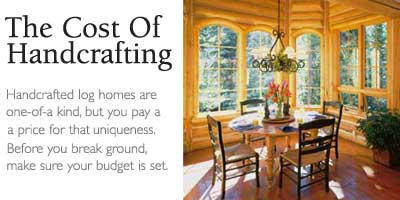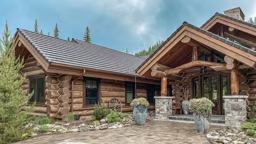
Most people build log homes for their distinctive look and feel. One way to guarantee yours is one-of-a-kind: choose handcraftsmanship over a standard milled or manufactured log home. Handcrafted homes feature logs left in their natural state. They haven't been milled or cut to a uniform size and dimension. Only their outer bark is removed. The knots, burls and other natural characteristics of the logs are accentuated to create a rare beauty. But this unique character comes at a price. The idea of having a handcrafted home might be appealing, but it may not be the best choice for you--or your wallet.
Before you break ground, do your homework and crunch those numbers to be sure you're making the right decision for you and your budget. One of the biggest mistakes people make when pricing log packages is assuming specific components are included. If it's not noted in writing, don't assume anything is included, warns Joe Folker, director of network services for Kuhns Bros. Log Homes in Lewisburg, Pennsylvania. "Give yourself enough time so you're not rushed through the research stage," he recommends. "Visit a manufacturer to get a complete catalog, which details what is -- and isn't -- included in the package."
For many folks considering a handcrafted home, it boils down to an aesthetic preference, says Folker. "It's a matter of what you want. Larger timbers have a different look," he says. "Customers interested in Kuhns wouldn't compare our package to a handcrafted home because there's a huge difference visually. Most people love handcrafted. But when they find out the price, they take a step back."
When designing your home, keep it simple, advises Lloyd Beckedorf, owner of Moose Mountain Log Homes in Alberta, Canada. He's watched homeowners "throw money away" by not fully considering their design. Consider functionality, too. For example, a wall separating the kitchen and bath will have plumbing and wiring running through it. So, a less expensive conventional wall makes more sense. Also, allocate as much living space under one roof as possible. A bungalow with a loft area is more cost-effective than a bungalow with open-beamed ceilings. Design elements such as dormers and balconies can add character to a simple rectangular house, but beware: they'll also add to the price tag.
Another area where some skimp: wood species. Some species are cheaper than others and may offer short-term financial gain. But you still need to make sure you choose the species best suited to your location's climate. "If you're building in a very wet environment, cedar is best," Beckedorf says. "You may be able to use spruce but it might not last as long. You won't save in the long run."
Personal preference also plays a role. You may want smooth log walls or maybe you prefer natural knots. Be sure to research which wood species are more prone to checking or cracking so you're not disappointed. Finally, Beckedorf says many customers have shaved labor costs by investing sweat equity in their homes. This solution is visible, but isn't for everyone. "Do you have the expertise to do an adequate job? Do you have time to actually do the work?" Beckedorf asks clients. "If your income is reduced and you become burnt out spending all your free time working, you may not come out ahead." The bottom line? "Doing thorough research up front and evaluating the quality of materials and joinery techniques is the best way to get the best value for your money," Beckedorf says.








_11868_2024-09-17_08-44-256x288.avif)


